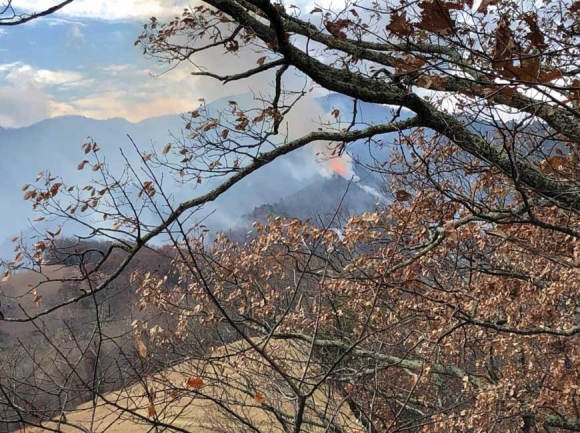Rain quells Cold Mountain Fire at 200 acres
 Flames rise from Cold Mountain. USFS photo
Flames rise from Cold Mountain. USFS photo
A fire in the Shining Rock Wilderness Area burned about 200 acres last week after a 911 call at 3 p.m. Thursday, Nov. 21, alerted authorities to the blaze, but heavy rain Saturday helped halt its growth.
The cause of the fire is still under investigation, but there was no lightning in the area at the time the fire began. It’s likely the fire was the result of human activity, said Public Information Officer Bruce MacDonald.
No structures were damaged, and while the fire did affect a small amount of private property, it was otherwise confined to federal land in the Pisgah National Forest. The Shining Rock Wilderness, including its 53 miles of trails, from Thursday morning through Monday night, Nov. 25. As of press time Monday evening the closure area had been reduced to include only the area east of Deep Gap within the Shining Rock Wilderness. The closure area includes the Cold Mountain Summit Trail.
While no growth in the fire area is expected, firefighters will remain on site for the time being to monitor conditions and containment lines.
“We’re cautiously optimistic, but we’re not at the point now where we can call it good and walk away,” Public Information Officer Bruce MacDonald said in a Nov. 25 phone interview.
The blaze was named the Cold Mountain Fire after the iconic area it affected, a place that serves as the setting of the National Book Award-winning novel Cold Mountain and movie of the same name. The Haywood County Sheriff’s Office estimated the fire to be between 20 and 30 acres at 9:30 a.m. Thursday morning, with a U.S. Forest Service press release that evening stating that it had grown to about 106 acres. By midday Friday, the Forest Service estimate was 126 acres.
Related Items
While the estimated fire size jumped up to 200 on Saturday, MacDonald said that increase was not due to any actual fire growth but rather to more precise calculations. A heavy rain fell most of the day on Saturday, allowing incident managers to spend time more precisely mapping the area.
The rain “really knocked it down,” said MacDonald. “They (firefighters) did go out there yesterday afternoon (Sunday) by the heat of the day. There were a couple things still smoking, which wasn’t a complete surprise.”

As of press time, the Shining Rock Wilderness Area was closed east of Deep Gap. USFS map
Larger fuels can hold heat for a while, and fuels located in places that are sheltered from the rain can also remain active even after heavy precipitation. On Monday, crews further surveyed the area to determine where those smoking fuels were located — fuels in the fire’s interior cause little occasion for worry, while fuels located closer to the perimeter require closer monitoring.
At the top of everybody’s mind is the cautionary tale of the Chimney Tops Fire, a 2016 blaze that, like the Cold Mountain Fire, began just before Thanksgiving and was judged to be at low risk of metastasizing. But that prediction did not hold — a Nov. 28 windstorm brought the fuels to deadly life, creating a firestorm that swept down the mountain to burn much of Gatlinburg and cause 14 deaths.
During the briefing Monday morning, MacDonald said, incident managers reminded crews about the Gatlinburg disaster to instill the need to continue monitoring the fire closely.
“That was on everybody’s mind,” said MacDonald.
However, if the fire continues on its current petering-out trajectory, it will likely prove beneficial to the area in the long run. While the fire did include some high-intensity burns, those occurred in concentrated areas of especially flammable fuels, MacDonald said. For the most part, the flames were low and slow, going downhill.
“Moving down the hill it burns very low intensity, and actually sometimes doing just the kind of burning we’re trying to do with prescribed burning,” said MacDonald.
Prescribed burning is a tool land managers use to prevent fuel buildups that can lead to destructive wildfires and to restore fire-dependent landscapes, boosting plant and wildlife diversity. However, it’s expensive — finding the money to conduct needed burns is a perennial struggle for the Forest Service and other land management agencies.
While evaluation is ongoing, trail damage is not expected as a result of the fire. Most of the flames occurred away from trails, MacDonald said.
The western counties saw some significant drought this fall, with the N.C. Drought Monitor logging the first severe drought designation since April 25, 2017. Rains in the later part of October alleviated the drought, with conditions now restored to normal throughout Western North Carolina with the exception of a small area in southern Clay, Macon and Jackson counties labeled as abnormally dry. However, no major fires were reported in the region while drought conditions prevailed — the Cold Mountain Fire was the first significant blaze this fall, beginning after normal conditions had returned.
About 30 firefighters worked on response, representing the U.S. Forest Service, N.C. Forest Service, Haywood County Emergency Management, Cruso Fire Department and National Park Service.









